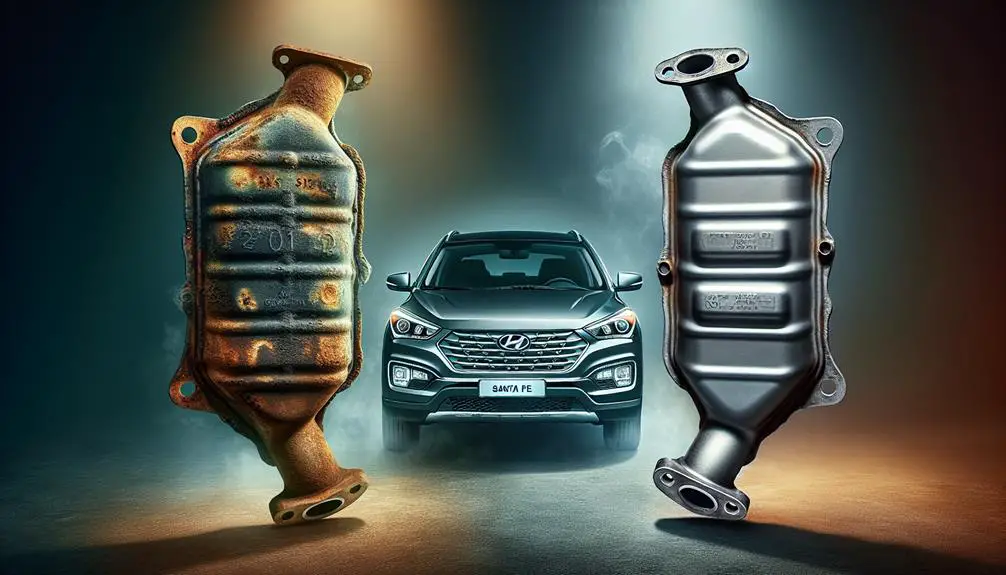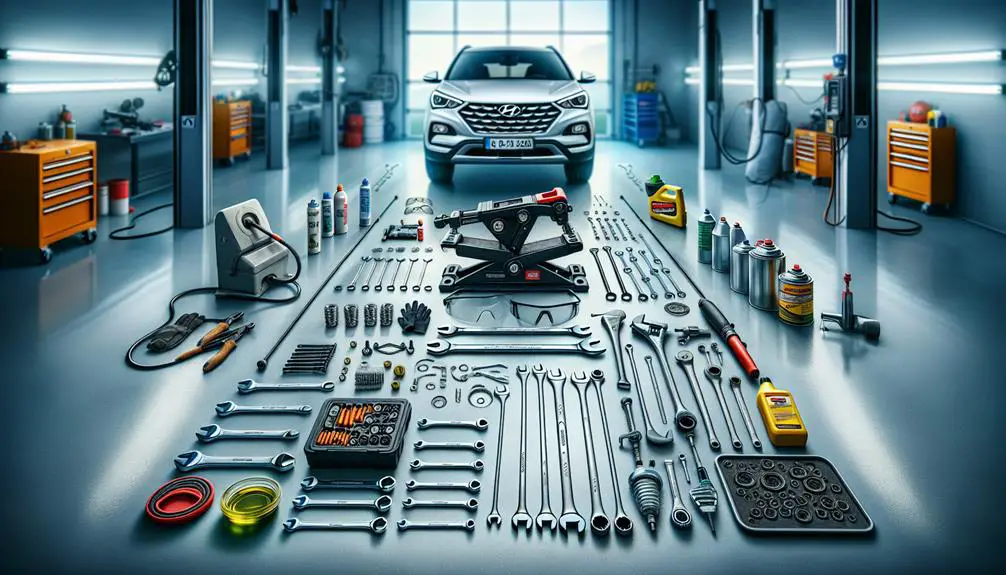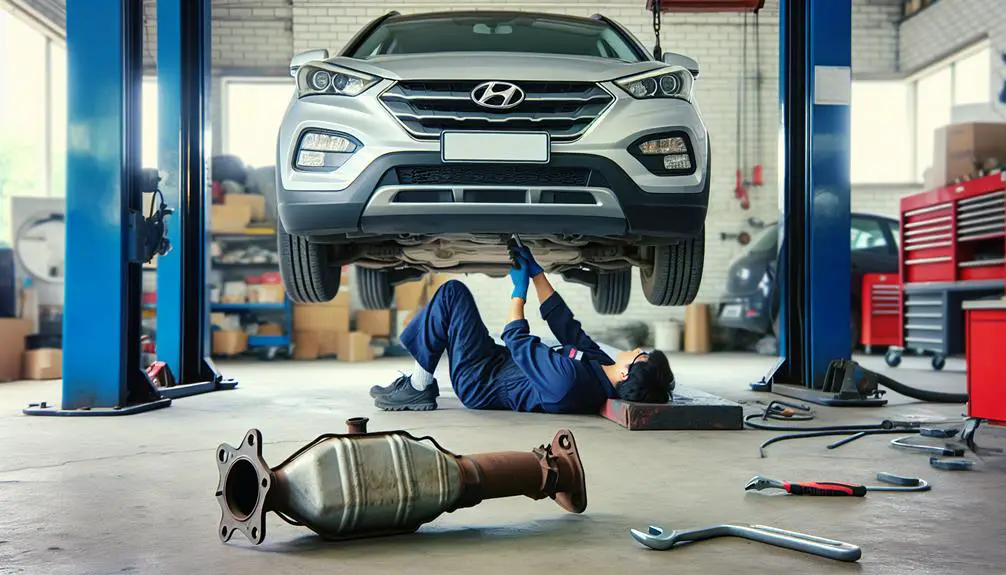Replacing the catalytic converter on a 2007 to 2012 Hyundai Santa Fe involves identifying the need for replacement. Selecting the appropriate converter is crucial to ensure compatibility and optimal performance. Using the right tools for removal and installation is essential to ensure the vehicle operates efficiently.
This process requires attention to detail and following the manufacturer's recommendations. Regular maintenance and inspection can help prevent the need for premature replacement.
Identifying Replacement Needs

Knowing when your Hyundai Santa Fe needs a new catalytic converter is critical to maintaining its performance and emissions compliance. You'll initially notice that something's off when your vehicle starts running less efficiently. If you're experiencing a significant decrease in fuel economy or your engine isn't performing as it should, it's time to pay attention.
A glaring red flag is the 'Check Engine' light flashing on your dashboard. While it can indicate different issues, a diagnostic check can reveal if it's related to your catalytic converter. Don't ignore unusual sounds either. A rattling noise from under your vehicle could mean the converter's internal structure is compromised.
You'll want to keep an eye on your vehicle's emissions. Visible smoke from the exhaust, especially if it's darker, indicates that your converter isn't processing exhaust gases properly. This isn't just bad for the environment; it could lead to your Santa Fe failing an emissions test, a situation you definitely want to avoid.
Choosing the Right Converter
After identifying your Hyundai Santa Fe's need for a new catalytic converter, it's important to select the right one to guarantee top performance and compliance with emissions standards. The market offers a variety of options, but not all are a perfect fit for your vehicle.
Initially, consider compatibility. Your Santa Fe's year, make, and model dramatically influence the type of catalytic converter you'll need. Manufacturers often produce vehicle-specific converters to ensure a seamless fit and optimal functionality. Don't guess; instead, check your vehicle's specifications or consult with a professional.
Next, focus on legal requirements. Different regions have distinct emissions standards. In the U.S., for example, California has stricter regulations compared to other states. Make sure the converter you choose meets the legal requirements of your area to avoid fines or failed emissions tests.
Lastly, think about quality and warranty. Opting for a high-quality converter from a reputable manufacturer might cost more upfront but can save you money and headaches in the long run. A solid warranty is also a good indicator of the converter's reliability.
Choosing the right catalytic converter isn't just about compliance; it's about ensuring your Hyundai Santa Fe runs smoothly and efficiently for years to come.
Gathering Necessary Tools

Before you initiate into replacing the catalytic converter on your Hyundai Santa Fe, it's essential to gather all the necessary tools for the job. This step is critical to make sure a smooth and efficient replacement process. Without the right tools, you might find yourself in a bind, wasting time, or possibly even damaging your vehicle.
Here's a list of the tools you'll definitely need:
- Socket Set: A thorough socket set is indispensable. You'll use it to remove and secure bolts and nuts. Make sure it includes both standard and deep sockets to reach all fasteners.
- Wrench Set: Some bolts might be in spots that are tough for a socket to reach. That's where a good set of wrenches comes in handy.
- Penetrating Oil: Rust and corrosion can make removing old parts a nightmare. Spraying some penetrating oil on the bolts a few hours before you start can save you a lot of effort.
- Jack and Jack Stands: Safety first! You'll need to elevate your Santa Fe to access the catalytic converter. Make sure you have a reliable jack and jack stands to keep the car securely lifted.
Arming yourself with these tools ensures you're prepared to tackle the job efficiently.
Removing the Old Converter
Start by safely elevating your Hyundai Santa Fe and securing it on jack stands to access the old catalytic converter. Once you've got your vehicle in a stable position, you'll need to locate the converter. It's usually found between the engine and the muffler, along the exhaust system.
Next, you'll want to spray penetrating oil on the bolts connecting the converter to the exhaust system. This step is important as it'll make loosening the bolts much easier. Give it a few minutes to work its magic.
After the penetrating oil has had time to settle, use the wrench or socket set you've gathered to slowly remove the bolts. Take your time here; rushing could strip the bolts, making them harder to remove. If you encounter any stubborn bolts, apply more penetrating oil and try again after a few minutes.
Once all the bolts are removed, carefully detach the old catalytic converter from the exhaust system. You might need to wiggle it a bit to free it from any hangers or if it's stuck because of corrosion.
Don't forget to inspect the area for any parts that might need cleaning or replacing before installing the new converter. This step guarantees a smoother installation process.
Installing the New Converter

With the old catalytic converter now removed, it's time to install the new one onto your Hyundai Santa Fe. You'll want to make sure the process goes smoothly to avoid any future issues. Here's how you can do it effectively:
- Prepare the Surface: Before installing the new converter, make sure the surface where it'll be mounted is clean. Remove any rust or debris to guarantee a tight seal. This step is important to prevent exhaust leaks.
- Position the New Converter: Carefully lift the new catalytic converter into place. It's vital to align it correctly with the exhaust system's mounting points. If it's not aligned properly, you might face difficulties securing it or it could cause performance issues down the line.
- Secure the Converter: Once the converter is in place, start by hand-threading the bolts to attach it securely. Don't tighten them fully yet. This allows some wiggle room to make sure all bolts can start without cross-threading.
- Tighten Everything Up: After all bolts are hand-started, go ahead and tighten them with a wrench. Do this in a crisscross pattern to make sure even pressure and prevent warping.
That's it! You've successfully installed a new catalytic converter on your Hyundai Santa Fe. Remember to double-check all connections and start your vehicle to make sure everything is functioning correctly.
Conclusion
To sum up, changing your Hyundai Santa Fe's catalytic converter doesn't have to be intimidating. Initially, ensure it's truly time for a replacement. Select the correct converter that aligns with your vehicle's specifications. Gather all the tools you'll need before beginning.
Carefully remove the old converter, taking note of how everything fits. Then, install the new one, reversing the removal steps. With patience and the right preparation, you'll have your Santa Fe running smoothly and efficiently in no time.